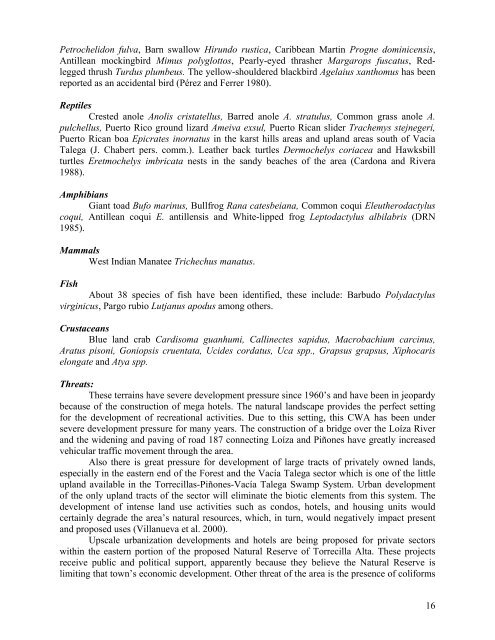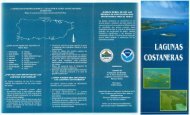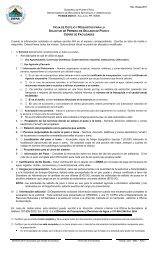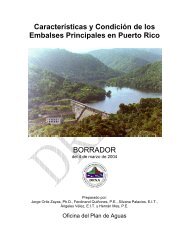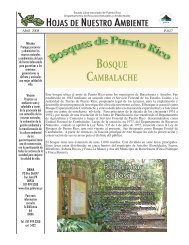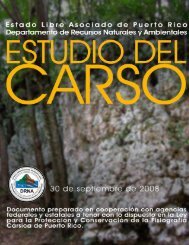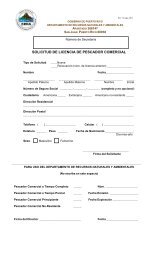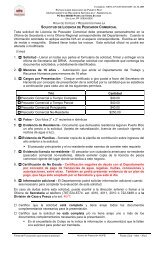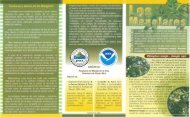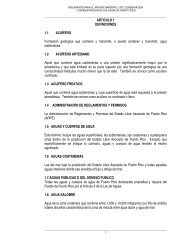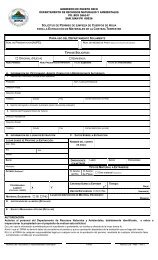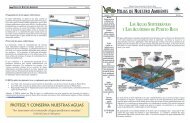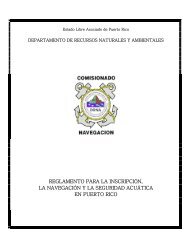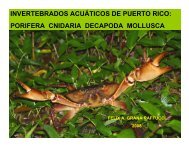Puerto Rico Critical Wildlife Areas - Puerto DRNA - Gobierno de ...
Puerto Rico Critical Wildlife Areas - Puerto DRNA - Gobierno de ...
Puerto Rico Critical Wildlife Areas - Puerto DRNA - Gobierno de ...
You also want an ePaper? Increase the reach of your titles
YUMPU automatically turns print PDFs into web optimized ePapers that Google loves.
Petrochelidon fulva, Barn swallow Hirundo rustica, Caribbean Martin Progne dominicensis,<br />
Antillean mockingbird Mimus polyglottos, Pearly-eyed thrasher Margarops fuscatus, Redlegged<br />
thrush Turdus plumbeus. The yellow-shoul<strong>de</strong>red blackbird Agelaius xanthomus has been<br />
reported as an acci<strong>de</strong>ntal bird (Pérez and Ferrer 1980).<br />
Reptiles<br />
Crested anole Anolis cristatellus, Barred anole A. stratulus, Common grass anole A.<br />
pulchellus, <strong>Puerto</strong> <strong>Rico</strong> ground lizard Ameiva exsul, <strong>Puerto</strong> Rican sli<strong>de</strong>r Trachemys stejnegeri,<br />
<strong>Puerto</strong> Rican boa Epicrates inornatus in the karst hills areas and upland areas south of Vacia<br />
Talega (J. Chabert pers. comm.). Leather back turtles Dermochelys coriacea and Hawksbill<br />
turtles Eretmochelys imbricata nests in the sandy beaches of the area (Cardona and Rivera<br />
1988).<br />
Amphibians<br />
Giant toad Bufo marinus, Bullfrog Rana catesbeiana, Common coqui Eleutherodactylus<br />
coqui, Antillean coqui E. antillensis and White-lipped frog Leptodactylus albilabris (DRN<br />
1985).<br />
Mammals<br />
West Indian Manatee Trichechus manatus.<br />
Fish<br />
About 38 species of fish have been i<strong>de</strong>ntified, these inclu<strong>de</strong>: Barbudo Polydactylus<br />
virginicus, Pargo rubio Lutjanus apodus among others.<br />
Crustaceans<br />
Blue land crab Cardisoma guanhumi, Callinectes sapidus, Macrobachium carcinus,<br />
Aratus pisoni, Goniopsis cruentata, Uci<strong>de</strong>s cordatus, Uca spp., Grapsus grapsus, Xiphocaris<br />
elongate and Atya spp.<br />
Threats:<br />
These terrains have severe <strong>de</strong>velopment pressure since 1960’s and have been in jeopardy<br />
because of the construction of mega hotels. The natural landscape provi<strong>de</strong>s the perfect setting<br />
for the <strong>de</strong>velopment of recreational activities. Due to this setting, this CWA has been un<strong>de</strong>r<br />
severe <strong>de</strong>velopment pressure for many years. The construction of a bridge over the Loíza River<br />
and the wi<strong>de</strong>ning and paving of road 187 connecting Loíza and Piñones have greatly increased<br />
vehicular traffic movement through the area.<br />
Also there is great pressure for <strong>de</strong>velopment of large tracts of privately owned lands,<br />
especially in the eastern end of the Forest and the Vacía Talega sector which is one of the little<br />
upland available in the Torrecillas-Piñones-Vacía Talega Swamp System. Urban <strong>de</strong>velopment<br />
of the only upland tracts of the sector will eliminate the biotic elements from this system. The<br />
<strong>de</strong>velopment of intense land use activities such as condos, hotels, and housing units would<br />
certainly <strong>de</strong>gra<strong>de</strong> the area’s natural resources, which, in turn, would negatively impact present<br />
and proposed uses (Villanueva et al. 2000).<br />
Upscale urbanization <strong>de</strong>velopments and hotels are being proposed for private sectors<br />
within the eastern portion of the proposed Natural Reserve of Torrecilla Alta. These projects<br />
receive public and political support, apparently because they believe the Natural Reserve is<br />
limiting that town’s economic <strong>de</strong>velopment. Other threat of the area is the presence of coliforms<br />
16


